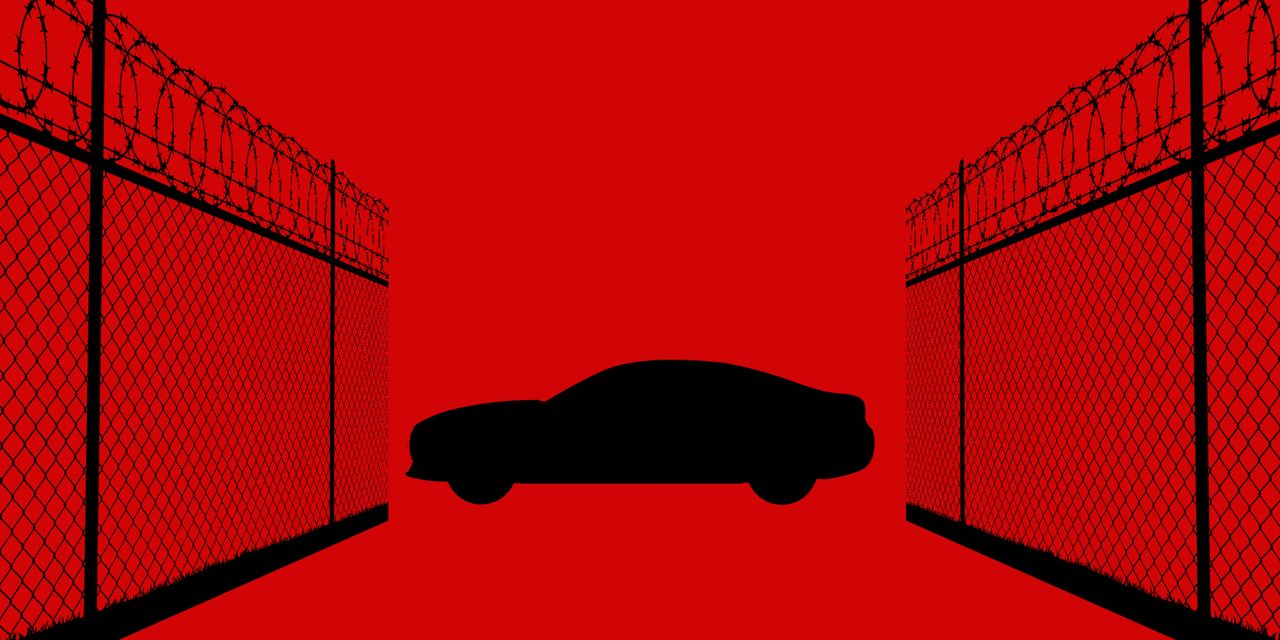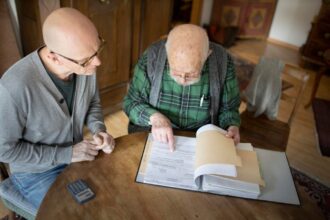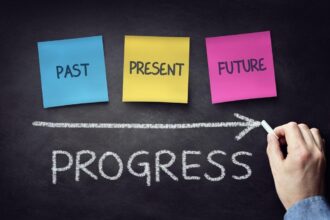In the American popular imagination, the car is a symbol of freedom. But in reality, for many, it can actually be a trap.
That’s one takeaway of “Cars and Jails: Freedom Dreams, Debt and Carcerality,” a book by Julie Livingston and Andrew Ross, professors at New York University (OR Books, November, 2022). The two, who work in a research lab at NYU with formerly incarcerated students, trace the pathways that lead Americans from cars to jails and from jails to cars and back again.
Throughout the book, Livingston and Ross document many moments of intersection between the central role cars play in American lives — both as a tool for survival and as a marker of identity and independence — and the carceral system.
Livingston and Ross detail many examples: Prisoners dreaming and talking about cars as a symbol of freedom while in jail; the clearing away of bad debts, sometimes racked up due to traffic fines that went unpaid while in jail, to reinstate a drivers’ license upon release; taking out subprime loans to buy a car after a period of incarceration tanked a released prisoner’s credit; being targeted for tickets once back out on the road or held in contempt of court for struggling to make auto loan payments; and then due to these interactions with the legal system, possibly winding up back in jail dreaming of a car once again.
“We can visualize and understand the cycle, but it’s not that any one individual often goes through the entire cycle, though certainly some people do,” Livingston said.
Auto loan debt, which is extremely common in the U.S., can be one factor that exacerbates the car to jail pipeline. In 2019, about 85% of new car buyers in the U.S. used a loan to pay for their car, according to Public Interest Research Groups, a consumer advocacy organization. In 2016, 26% of auto loan originations were made to borrowers with subprime and deep subprime credit scores, PIRG found.
In addition to scrutinizing the role of financing in the link between cars and jails, Ross and Livingston look at revenue-driven law enforcement and municipalities that rely on ticket revenue and associated court fees. They highlight the example of Ferguson, Mo., where in the wake of the shooting of Michael Brown, a Justice Department investigation found that city officials regularly pressured the police department and court staff to find ways to charge residents fines and fees. This strategy was employed in part to make up for budget shortfalls, the Justice Department found.
MarketWatch spoke to Livingston and Ross about the book and the role of cars — and debt to pay for them — in America. The conversation has been edited and condensed.
MarketWatch: Why did you all start looking at the relationship between cars and jails?
Julie Livingston: We’re interested in the relationship between the carceral system and the debt economy. When we began our research, we trained our students to go and take a set of debt inventories and general interviews with formerly incarcerated persons about that relationship. As Andrew and I started looking over the material we began to see that the car was appearing all over the place.
We didn’t start out interested in cars, but suddenly there they were. They were the sight of arrest, they also were the sight of debt and they sat in the middle through the driver’s license, which was being held as collateral against all different kinds of debt.
Andrew Ross: It was remarkable how many pathways we found and connections we found between the need to own and drive a car, and ending up behind bars, how smooth these pathways were, how easy it was actually to end up behind bars despite the fact that debtors’ prisons have been abolished since 1833 in this country. It was a real eye opener for us.
Courtesy of OR Books
MarketWatch: One thing you all highlighted in the book that I thought was really interesting was how declines in public funding have pushed municipalities to rely on revenue policing and how that impacts the car to jail pathway. I’m wondering if you can talk through what revenue policing is and also that trajectory.
Ross: The origins of revenue policing are in the speed trap, small towns used to set speed traps for passing motorists. We’ve all been through that and all fallen prey to those traps. In the last few decades or so revenue policing has become a much more systematic way of funding local government budgets in many, many jurisdictions as public funding has gotten squeezed largely because of reduction in taxation.
Not only is this a terrible way of funding government, it’s also a form of regressive taxation because in this country we have flat fines. The problem with flat fines is that they’re discriminatory because they don’t take into account the ability to pay.
MarketWatch: Can we talk through the other aspect of debt that’s involved here, which is the auto loan itself. Why are auto loans particularly pernicious? What is it about auto debt that’s really ensnaring people here?
Ross: Auto loan debt, which in the aggregate is over $1.5 trillion — not far below student debt — hasn’t gotten anything like the same kind of public scrutiny as student debt has. The figures are pretty staggering, auto loan debt has doubled over the last decade, largely as a result of the entry of subprime lending. It migrated from the housing market to the auto loan market and also because loan terms are much longer now, up to 84 months.
One of the upshots is the average monthly loan payment is over $700, which is a crazy amount of money. That doesn’t cover insurance of course, it doesn’t cover maintenance costs, it doesn’t cover the very lucrative after market where if you want a new battery or new transmission system or a new set of wheels — they can also be financed and increasingly they are — adding to the overall debt burden that’s carried on the car.
The net result of this really is a crushing burden on people and it’s not optional. If you don’t want student debt, you don’t have to go to college, but in almost all parts of this country, you have to have a car, so that is an automatic debt burden and it’s increasingly a crushing debt burden.
Just as with traffic fines, which can lead to detention, these civil debts can also put you behind bars. Mostly for contempt of court, technically speaking you can’t be jailed for failing to make a debt payment, but you can be jailed for contempt of court and that’s how creditors pursue auto loan debtors in the small claim courts of this country.
MarketWatch: You guys both spoke a little bit to this, but I’m wondering if we could dig into it a bit more — why isn’t there as much attention both in a political, public imagination sense and also regulatory sense to this kind of debt?
Ross: There is a lack of public outrage about it and that speaks to how normalized it is, how accepting we are of that kind of hustle as one of the normal things of just buying a car.
We have a student debt movement that pushes for college for all, we have a housing justice movement that pushes for housing for all and we have a Medicare for all movement in the health care sector. We don’t have a transportation for all movement in this country. Without that pressure, lawmakers are not inclined to take action as a result.
Livingston: The creep of the auto loan system and the creeping price of the car, alongside the size of the car, there’s a way in which as it gets baked into the American landscape and becomes difficult for Americans to unthink the car. It’s just so obvious how much public space we give over to it, how much of our lives are spent in service to it, it just looks like air that you breathe and water that you drink, of course you need a car, of course adults drive cars, of course learning to drive is a right of passage — all of the ways the car is enshrined in the American landscape as a symbol of freedom.
One of the paradoxes that we found in the book was over and over and over again people that we talked to who had been arrested while driving a car, who had cars that had been repossessed, who were running on a wheel in service of their car described driving as an experience of freedom.
One thing that we saw that was very insidious inside of the subprime loan was the way that some people were being upsold into more expensive and luxurious models than they could afford, even though they went to the dealership wanting a cheaper model. They often found themselves upsold. Once you’re upsold you’re not occupying a righteous position in the public imaginary because there you are in your Mercedes, there you are in your Ford
F,
F150, there you are in this object that everyone else desires so what on earth are you complaining about?
MarketWatch: Can you talk through how auto debt is “bad debt” as compared to student debt or a mortgage?
Livingston: If you purchase a house or an apartment with a mortgage the hope and expectation is that it’s going to increase in value over time, but the second you drive your car off the lot it decreases in value and every mile you drive on it and every day it ages it decreases in value.
Many people that we talk to and many many people in this country are what is called upside down on their loan, they owe more on it than it’s worth, so by the time they sell it, they’re selling this negative equity and rolling it into the next car. That is very different than how people at least hope real estate works
We know from people like Keeanga-Yamahtta Taylor, who writes about predatory inclusion in the housing market and questions of racial justice — that that is not always the case in housing, so I don’t want to overstate the comparison. There are all kinds of racial predations that are shot through these systems, but in a normative frame, I think that that comparison holds between the house and the car.
Ross: You could say the same about education. There are people who advocate for user-financed education — as educators, we don’t, we think it’s a terrible way of financing education — but those who do advocate for it pull out statistics to show that a college degree over the course of a lifetime does magnify your income. They usually don’t include the numbers that show the drag on that income of having to pay off your student debt, but that’s a whole other issue.
That’s tantamount to saying that from a certain angle a college education could be perceived as an appreciator of the value of your household income over time, in the same way as a house might. There are racialized factors that mitigate against that being accessible to everyone, minority students hold by far the greatest debts by proportion on graduation and for much longer after graduation. [Still], These two assets are in a completely different ball park from the asset that we call a car.
MarketWatch: How did COVID play a role in the relationship between cars and jails?
Ross: There was a moratorium in the housing sector and the education sector, there was no comparable action taken in the auto-loan debt [sector], so people had to keep on making payments and the business of repossessing cars went on as usual and I guess in retrospect we might ask well why was that the case?
The government during that emergency period of the pandemic didn’t think it necessary to intervene in the business of transportation in the same way as it did to provide household relief in the sphere of education and in the sphere of housing. That’s significant and I think it does speak to this general perception of ours, having written this book, that there is a considerable neglect and lack of scrutiny and overall lack of regulation of this entire landscape.
Read the full article here










